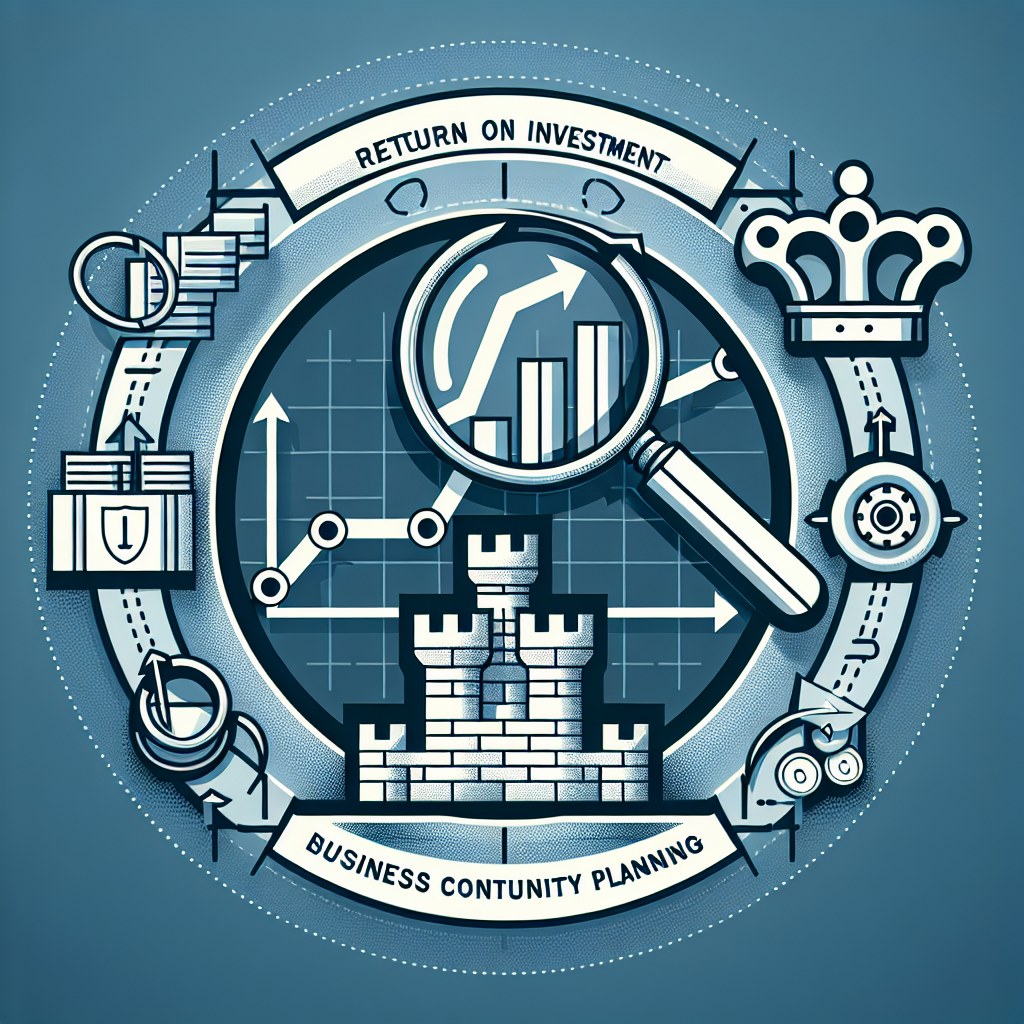Your cart is currently empty!
Tag: Planning

The ROI of Investing in Business Continuity Planning for Your Organization
In today’s fast-paced and ever-changing business environment, it is crucial for organizations to have a solid business continuity plan in place. Business continuity planning involves creating a strategy to ensure that essential business functions can continue even in the face of a disaster or unexpected event. While some organizations may see this as an unnecessary expense, the return on investment (ROI) of investing in business continuity planning can be significant.One of the key benefits of having a business continuity plan is the ability to minimize downtime in the event of a disaster. Whether it’s a natural disaster, cyber attack, or other unforeseen event, having a plan in place can help your organization quickly recover and resume operations. This can prevent costly disruptions to your business and help you maintain customer trust and loyalty.
Additionally, investing in business continuity planning can help your organization comply with regulatory requirements and industry standards. Many industries have specific regulations that require businesses to have a plan in place to ensure continuity of operations. By investing in a business continuity plan, you can avoid costly fines and penalties for non-compliance.
Furthermore, having a business continuity plan can also help you protect your organization’s reputation. In the event of a disaster, how your organization responds can have a significant impact on how your customers and stakeholders perceive your business. Having a well-thought-out plan in place can help you respond quickly and effectively, demonstrating your commitment to ensuring the continuity of your operations.
Lastly, investing in business continuity planning can also help you save money in the long run. While there is an upfront cost associated with creating and implementing a business continuity plan, the potential cost savings from preventing downtime and minimizing disruptions far outweigh the initial investment. In fact, studies have shown that for every dollar spent on business continuity planning, organizations can save up to four dollars in potential losses.
In conclusion, the ROI of investing in business continuity planning for your organization is undeniable. By having a plan in place, you can minimize downtime, comply with regulatory requirements, protect your reputation, and save money in the long run. So, don’t wait until it’s too late – start investing in business continuity planning today to ensure the resilience and continuity of your organization.

From Problem Solving to Strategic Planning: The Value of IT Consulting in Today’s Business Landscape
In today’s fast-paced and ever-evolving business landscape, the role of IT consulting has become increasingly crucial. IT consultants play a vital role in helping organizations navigate the complex world of technology, from problem solving to strategic planning. They bring a unique perspective and expertise that can help businesses stay ahead of the competition and drive innovation.One of the key benefits of IT consulting is its ability to help organizations solve complex problems. Whether it’s troubleshooting a technical issue or implementing a new software solution, IT consultants have the knowledge and skills to find effective solutions quickly and efficiently. By leveraging their expertise, businesses can avoid costly downtime and ensure that their systems are running smoothly.
But IT consulting goes beyond just problem solving – it also plays a critical role in strategic planning. In today’s digital age, technology is a key driver of business success. IT consultants can help organizations develop a comprehensive IT strategy that aligns with their overall business goals and objectives. This can include everything from optimizing existing systems to implementing new technologies that will drive growth and innovation.
Furthermore, IT consultants can provide valuable insights and recommendations on emerging technologies and trends that can give businesses a competitive edge. Whether it’s cloud computing, artificial intelligence, or cybersecurity, IT consultants can help organizations stay ahead of the curve and make informed decisions about their technology investments.
In addition, IT consulting can also help businesses streamline their operations and improve efficiency. By optimizing processes and implementing automation tools, IT consultants can help organizations reduce costs, increase productivity, and drive business growth. This can have a significant impact on the bottom line and help businesses achieve their strategic objectives.
Overall, the value of IT consulting in today’s business landscape cannot be overstated. From problem solving to strategic planning, IT consultants play a critical role in helping organizations leverage technology to drive innovation and growth. By partnering with an experienced IT consulting firm, businesses can gain a competitive edge and achieve long-term success in today’s digital world.

The Importance of Business Continuity Planning in a Digital Age
In today’s digital age, businesses rely heavily on technology to operate efficiently and effectively. From storing important data in the cloud to communicating with clients and employees through online platforms, technology plays a crucial role in driving business success. However, with the increasing reliance on digital systems, the risk of disruptions and disasters has also become more prevalent. This is where business continuity planning comes into play.Business continuity planning is a proactive approach to identifying and preparing for potential disruptions that could impact a business’s operations. These disruptions could include natural disasters, cyber-attacks, system failures, or even human error. By having a comprehensive business continuity plan in place, businesses can minimize downtime, reduce financial losses, and protect their reputation in the event of a disaster.
In the digital age, the importance of business continuity planning cannot be overstated. With so much of a business’s operations relying on technology, any disruption to these systems can have a significant impact on the organization. For example, a cyber-attack could lead to a data breach, causing sensitive information to be compromised and damaging the trust of clients and customers. Without a proper plan in place, businesses may struggle to recover from such an incident and could face long-term consequences.
Additionally, with the rise of remote work and online communications, businesses need to ensure that their digital systems are secure and resilient. A well-designed business continuity plan can help businesses navigate the complexities of remote work and ensure that employees can continue to work effectively, even in the face of disruptions.
Furthermore, having a business continuity plan in place can also give businesses a competitive edge. In today’s fast-paced and ever-changing business landscape, customers expect organizations to be able to adapt and respond quickly to challenges. By demonstrating that they have a solid business continuity plan in place, businesses can instill confidence in their clients and partners, showing that they are prepared to weather any storm.
Ultimately, the importance of business continuity planning in a digital age cannot be understated. By taking proactive steps to identify and mitigate potential risks, businesses can ensure that they are well-prepared to handle any disruptions that come their way. Investing in a robust business continuity plan is not only a smart business decision but also a crucial step in safeguarding the future success of the organization.

Creating a Resilient Business: The Benefits of Business Continuity Planning
In today’s unpredictable world, it is more important than ever for businesses to be prepared for any potential disruptions. From natural disasters to cyber attacks, there are countless threats that can impact a company’s operations. This is why having a business continuity plan in place is crucial for ensuring the resilience and longevity of a business.Business continuity planning involves creating a strategy to ensure that essential functions can continue in the event of a disruption. This includes identifying potential risks, developing recovery strategies, and implementing measures to minimize the impact of any disruptions. By having a robust business continuity plan in place, businesses can not only survive unexpected challenges but also thrive in the face of adversity.
One of the key benefits of business continuity planning is that it helps businesses minimize downtime and maintain operations during a crisis. By having a plan in place, companies can quickly respond to disruptions and implement strategies to keep their operations running smoothly. This can help businesses avoid significant financial losses and maintain customer trust and loyalty.
Another benefit of business continuity planning is that it helps businesses protect their reputation and brand image. In times of crisis, how a company responds can have a lasting impact on its reputation. By having a well-thought-out business continuity plan in place, businesses can demonstrate their commitment to their customers, employees, and stakeholders, building trust and credibility in the process.
Additionally, business continuity planning can help businesses comply with regulations and legal requirements. Many industries have specific regulations that require businesses to have contingency plans in place to ensure the safety and security of their operations. By having a robust business continuity plan, companies can demonstrate their compliance with these regulations and avoid potential fines and penalties.
Overall, creating a resilient business through business continuity planning is essential for ensuring the long-term success and sustainability of a company. By investing the time and resources into developing a comprehensive plan, businesses can protect themselves from potential threats and position themselves for growth and success in the future. In today’s fast-paced and uncertain business environment, having a business continuity plan is no longer optional – it is a necessity for businesses of all sizes and industries.

The Role of Remote Monitoring in Disaster Recovery Planning
Disasters can strike at any time, from natural disasters like hurricanes and earthquakes to man-made disasters like cyberattacks and power outages. In order to protect their businesses and ensure continuity in the face of such events, organizations must have a solid disaster recovery plan in place. And a key component of any effective disaster recovery plan is remote monitoring.Remote monitoring involves the use of technology to monitor and manage a company’s IT infrastructure from a remote location. This can include monitoring servers, networks, applications, and other critical systems in real-time, allowing IT teams to quickly identify and respond to any issues that arise.
One of the major benefits of remote monitoring in disaster recovery planning is the ability to detect problems before they escalate into full-blown disasters. By continuously monitoring systems and applications, IT teams can identify potential issues early on and take proactive measures to address them before they cause any significant downtime or data loss.
Remote monitoring also plays a crucial role in ensuring that critical systems are backed up and secure. By monitoring backup systems and data replication processes, organizations can ensure that their data is protected and accessible in the event of a disaster. This can help minimize downtime and ensure that business operations can resume as quickly as possible following a disaster.
In addition, remote monitoring can help organizations comply with regulatory requirements and industry standards related to disaster recovery and data protection. By monitoring systems and documenting processes, organizations can demonstrate that they have taken the necessary steps to protect their data and ensure business continuity in the event of a disaster.
Overall, remote monitoring is a critical component of any effective disaster recovery plan. By continuously monitoring systems, applications, and data, organizations can proactively identify and address potential issues, minimize downtime, and ensure business continuity in the face of disasters. Investing in remote monitoring technology can help organizations better protect their data, minimize the impact of disasters, and ensure that they are able to quickly recover and resume operations following a disruptive event.

The Importance of Business Continuity Planning: A Guide for Companies
In today’s fast-paced and unpredictable business environment, it is more important than ever for companies to have a solid business continuity plan in place. Business continuity planning is the process of creating a roadmap that outlines how a company will continue to operate during and after a disruptive event, such as a natural disaster, cyber attack, or pandemic.Having a business continuity plan can help companies minimize the impact of disruptions on their operations, employees, customers, and bottom line. By identifying potential risks and developing strategies to mitigate them, companies can ensure that they are prepared to respond quickly and effectively when a crisis strikes.
One of the key benefits of business continuity planning is that it helps companies maintain business continuity and ensure the uninterrupted delivery of products and services to customers. This can help companies maintain their reputation and customer loyalty, even in the face of a crisis.
Business continuity planning also helps companies protect their employees and assets. By having a plan in place, companies can ensure the safety and well-being of their employees during a crisis and minimize the loss of valuable assets.
Moreover, having a business continuity plan can also help companies comply with regulatory requirements and industry standards. Many industries require companies to have a business continuity plan in place to ensure that they can continue to operate in a safe and secure manner.
In addition, having a business continuity plan can help companies save time and money in the long run. By investing in proactive planning and preparation, companies can reduce the costs associated with responding to and recovering from a crisis.
Overall, business continuity planning is an essential component of a company’s risk management strategy. By taking the time to develop a comprehensive plan, companies can ensure that they are prepared to navigate any challenges that come their way and emerge stronger on the other side. It is important for companies of all sizes and industries to prioritize business continuity planning to protect their employees, assets, and reputation in the face of disruptive events.

The Importance of Disaster Recovery Planning: A Comprehensive Guide
In today’s digital age, businesses rely heavily on technology to operate efficiently and effectively. From storing important data to communicating with clients and customers, technology plays a crucial role in the day-to-day operations of any organization. However, with the increasing reliance on technology comes the risk of disasters that can disrupt business operations and cause significant financial losses. This is where disaster recovery planning becomes essential.Disaster recovery planning is the process of creating a strategy to ensure that a business can continue to operate in the event of a disaster, such as a cyberattack, natural disaster, or system failure. This comprehensive guide will outline the importance of disaster recovery planning and provide tips on how to create an effective plan for your business.
One of the main reasons why disaster recovery planning is so important is that it helps businesses minimize downtime and recover quickly from any disruptions. In the event of a disaster, every minute that a business is unable to operate can result in lost revenue and damage to its reputation. By having a solid disaster recovery plan in place, businesses can ensure that they are able to resume operations as quickly as possible and minimize the impact of the disaster on their bottom line.
Additionally, disaster recovery planning helps businesses protect their valuable data and information. In today’s digital world, data is one of the most valuable assets that a business possesses. Losing important data can have serious consequences, including financial losses, legal issues, and damage to the business’s reputation. By creating a disaster recovery plan that includes regular backups and data recovery procedures, businesses can ensure that their data is safe and secure in the event of a disaster.
Furthermore, disaster recovery planning can help businesses comply with regulatory requirements and industry standards. Many industries have specific regulations that require businesses to have a disaster recovery plan in place to protect sensitive data and ensure business continuity. By creating a comprehensive disaster recovery plan, businesses can demonstrate to regulators and stakeholders that they are taking the necessary steps to protect their data and ensure business continuity in the event of a disaster.
So, how can businesses create an effective disaster recovery plan? Here are some tips to get started:
1. Assess the risks: Identify potential threats and vulnerabilities that could disrupt your business operations, such as cyberattacks, natural disasters, and system failures.
2. Define your objectives: Clearly define the goals and objectives of your disaster recovery plan, including the desired recovery time and recovery point objectives.
3. Develop a strategy: Create a detailed plan that outlines the steps to be taken in the event of a disaster, including data backup procedures, recovery procedures, and communication protocols.
4. Test and update your plan: Regularly test your disaster recovery plan to ensure that it is effective and up to date. Make any necessary adjustments based on the results of your tests.
In conclusion, disaster recovery planning is a critical component of any business’s overall risk management strategy. By creating a comprehensive disaster recovery plan, businesses can protect their data, minimize downtime, and ensure business continuity in the event of a disaster. By following the tips outlined in this guide, businesses can create an effective disaster recovery plan that will help them weather any storm.

Data Backup and Recovery: A Vital Component of Business Continuity Planning
In today’s digital age, businesses rely heavily on their data to operate efficiently and effectively. From customer information to financial records, data is the lifeblood of any organization. However, with the increasing threat of cyber attacks, natural disasters, and human error, data loss is a very real possibility. This is why data backup and recovery is a vital component of business continuity planning.Data backup involves creating copies of important information and storing them in a secure location. This ensures that if the original data is lost or compromised, it can be easily restored. There are various methods of data backup, including cloud storage, external hard drives, and tape backups. It is important for businesses to regularly back up their data to minimize the risk of data loss.
Data recovery, on the other hand, involves restoring lost or corrupted data from backups. This process can be time-consuming and costly, depending on the extent of the data loss. Having a solid data recovery plan in place is crucial for businesses to minimize downtime and prevent loss of revenue.
Business continuity planning is the process of creating strategies and procedures to ensure that a business can continue to operate in the event of a disruption. Data backup and recovery are key components of business continuity planning, as they help businesses recover quickly from data loss and resume normal operations.
There are several reasons why data backup and recovery are essential for business continuity planning. Firstly, data loss can result in financial loss and damage to a company’s reputation. For example, if a business loses customer data due to a cyber attack, it can lead to legal consequences and loss of trust from customers. Additionally, data loss can disrupt operations and result in downtime, which can impact productivity and revenue.
Having a solid data backup and recovery plan in place can help businesses mitigate the risks associated with data loss. By regularly backing up data and implementing robust recovery procedures, businesses can minimize the impact of data loss on their operations.
In conclusion, data backup and recovery are vital components of business continuity planning. By implementing a solid data backup and recovery plan, businesses can ensure that their critical information is protected and that they can quickly recover from any data loss incidents. Investing in data backup and recovery solutions is essential for any business looking to safeguard their data and maintain operational resilience.

Protecting Your Business: The Essentials of Disaster Recovery Planning
Disasters can strike at any time, and they can have devastating effects on businesses of all sizes. From natural disasters like hurricanes and earthquakes to cyberattacks and data breaches, there are many potential threats that can disrupt your business operations and put your company at risk. That’s why it’s essential to have a disaster recovery plan in place to protect your business and ensure that you can bounce back quickly in the event of a disaster.A disaster recovery plan is a comprehensive strategy that outlines how your business will respond to and recover from a disaster. It includes procedures for minimizing damage, preserving data, and restoring operations as quickly as possible. Without a solid disaster recovery plan in place, your business could face serious consequences, such as financial losses, damage to your reputation, and even the risk of closure.
So, what are the essentials of disaster recovery planning? Here are some key components to consider when creating your plan:
1. Identify potential risks: The first step in creating a disaster recovery plan is to identify the potential risks that could impact your business. This could include natural disasters like floods, fires, and earthquakes, as well as man-made disasters like cyberattacks and data breaches. By understanding the risks that your business faces, you can develop a plan that addresses these specific threats.
2. Develop a communication plan: Communication is key during a disaster, so it’s important to have a clear and effective communication plan in place. This should include contact information for key personnel, vendors, customers, and other stakeholders, as well as protocols for keeping everyone informed and updated during a crisis.
3. Back up your data: Data is one of the most valuable assets of any business, so it’s crucial to regularly back up your data and store it in a secure location. This will ensure that you can quickly recover your data in the event of a disaster, minimizing downtime and preventing loss of critical information.
4. Establish a recovery team: Designate a team of employees who will be responsible for implementing your disaster recovery plan. This team should be trained on the plan and be ready to act quickly in the event of a disaster. Assign specific roles and responsibilities to ensure that everyone knows what to do during a crisis.
5. Test and update your plan regularly: A disaster recovery plan is only effective if it’s regularly tested and updated. Conduct regular drills and simulations to ensure that your plan is up to date and that your team is prepared to respond to a disaster. Make any necessary revisions based on feedback from these tests and updates to your business operations.
In conclusion, disaster recovery planning is essential for protecting your business from potential threats and ensuring that you can recover quickly in the event of a disaster. By identifying potential risks, developing a communication plan, backing up your data, establishing a recovery team, and testing and updating your plan regularly, you can minimize the impact of a disaster on your business and keep your operations running smoothly. Don’t wait until it’s too late – start creating your disaster recovery plan today to protect your business for the future.

